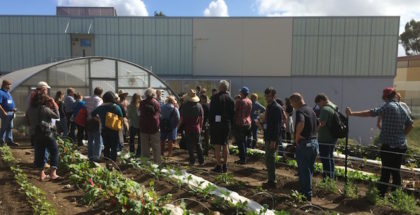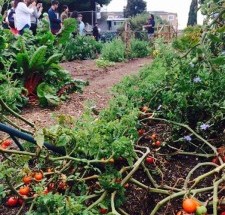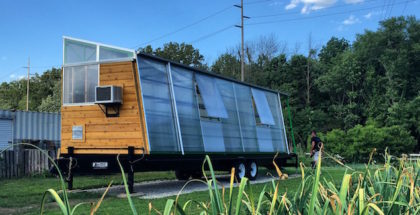Once the Largest Farming County in US, Los Angeles’s Agricultural Roots Laid Bare in New Book
September 2, 2016 | Karen Briner

Book cover image for “From Cows to Concrete: How Farming Transformed Los Angeles County” © 2016 by Rachel Surls and Judith Gerber, published by Angel City Press. All rights reserved. Image used with permission.
Only a bird’s eye view truly reveals the extent of Los Angeles’s urban sprawl; a city crossed by ribbons of highways supporting unending streams of cars, where even its river is mostly encased in concrete. It’s hard to imagine that this was once a fertile place of such abundance that its name conjured up images of vineyards, orange groves and orchards; in which neighborhoods were better known for their celery than their celebrities. A timely new book, From Cows to Concrete: the Rise and Fall of Farming in Los Angeles, by Rachel Surls and Judith Gerber explores Los Angeles’s past as the agricultural center of North America, tracing its precipitous path as it developed into a concrete metropolis. It’s a cautionary tale that also offers hope for the future in the form of the burgeoning urban farm movement and a renewed interest in community and backyard gardening.
Seedstock recently spoke to co-author, Rachel Surls, Sustainable Food Systems Advisor at the University of California where her job includes overseeing a volunteer program of 300 trained master gardeners who teach local communities sustainable gardening. She also leads a statewide project to provide resources and training for urban farmers, as well as working closely with the Los Angeles Food Policy Council.
Seedstock: What inspired you and Judith to write this book?
Rachel Surls: About fifteen years ago I was reviewing some old farming statistics for Los Angeles and it just struck me that this used to be a really big farming center. I dug a little further and found that, in fact, it was the largest farming county in the United States for about forty years in the 20th century. So it was a huge farming center that faded away and became a large urban center in a fairly short period of time. I became fascinated with that history. My co-author, Judi Gerber, grew up in the Los Angeles area and saw the small farms slowly disappear. We both had the same goal of sharing this largely forgotten history with Angelenos today.
Seedstock: How did Los Angeles develop into an agricultural center?
Rachel Surls: From its earliest existence Los Angeles was an agricultural center because the pueblo of Los Angeles was established to grow food to shore up the Spanish colonization of Southern California. Los Angeles’s main economy was producing cattle and it wasn’t until those giant cattle ranches collapsed in the 1860s that you really saw the rise of what we think of as farming today. The amazing diversity of crops came about because after the end of the rancho era, people were looking for ways to make a living. They started experimenting with everything from beekeeping to growing fruits and vegetables and over time some really successful crops arose.
Seedstock: How long did it take Los Angeles to go from pastoral setting to urban sprawl?
Rachel Surls: That happened starting in the 1860s, after the railroad arrived in Los Angeles and many more people started to come here. You saw subsequent land booms where people bought up land and developed it. Where you really saw the pastoral nature of Los Angeles convert to urban sprawl was after World War II. That was when the value of property went up tremendously. It was now worth far more for development than it was for farmland and you saw the conversion of thousands of acres of farmland into subdivisions.
Seedstock: What else was grown here?
Rachel Surls: There were so many crops here it was amazing. The Venice area, for example, was known as the celery capital of the world. Wheat was a huge crop and there were many orchard crops; peaches, apples, cherries, and almonds. The most iconic crops were citrus. Oranges in particular became part of the whole mythology of Los Angeles – a place with sunshine and beautiful orange fruit on every tree is part of what brought people to Los Angeles. There was animal agriculture too. Beekeeping was huge, there were poultry ranches and hundreds of dairies.
Seedstock: What brought about the demise of agriculture?
Rachel Surls: After World War II so many people came here and they wanted nice suburban homes with schools, shopping districts and freeways. Land prices started going up tremendously and farmers simply got edged out because the taxes skyrocketed to the point that they could no longer afford their property taxes. As farms started to fold, the infrastructure started to fold as well. Farmers were unable to sustain their operations and ultimately had to sell their land.
Seedstock: Could you talk about the current state of urban agriculture in Los Angeles?
Rachel Surls: We still have plenty of traditional agriculture in Los Angeles. In the Antelope Valley area there’s large scale carrot, onion, and alfalfa production, as well as peach and cherry orchards and nursery crop production. We also have emerging urban agriculture in the form of school gardens and community gardens. People are also converting vacant lots into mini farms and selling some of the fruits and vegetables that they grow. We’ve been seeing more of this since about 2008, when we had the big economic crisis. People have found that it’s satisfying to grow your own food and it’s also fulfilling a need in some urban neighborhoods where there’s simply not enough healthy, affordable fresh produce.
Seedstock: What does the future look like for urban agriculture in Los Angeles?
Rachel Surls: We have policies that are helping to promote the growth of urban agriculture. The Urban Agriculture Incentives Zone Act (AB551) was passed in the state legislature a couple of years ago. Local communities have to put their own programs into place and Los Angeles County recently did that and the City of Los Angeles is moving in that direction. This will give private land owners a property tax reduction to offer their land for use as urban agriculture. There’s also new state laws that make it easier to legally sell what you grow in an urban agriculture setting. I think, though, the real wild card is water. How will water be priced? How will it be accessible? Can urban farmers successfully convert to using less water? I think that’s the big question.
Seedstock: Obviously LA can’t return to its former pastoral glory, but to what extent can the green come back?
Rachel Surls: I think a lot of the hope comes from individuals. In the last five to ten years there’s been a renaissance of Americans gardening, doing home gardening, community gardening, container gardening. I think that through activities like these we have opportunity to bring very small pieces of land back into production.
Seedstock: To what extent is the story of Los Angeles a cautionary tale?
Rachel Surls: I think it’s very much a cautionary tale, especially for California. Los Angeles County paved over its farmland on a very fast, precipitous scale, but other counties in California have mostly continued on this same trajectory. In the U.S. we’re losing nearly 40 acres of farmland every hour and in California we’re losing around 50 thousand acres per year. If we don’t protect our farmlands we lose our capacity to grow food and farm products, and we erode other benefits that farms provide communities, such as mitigation of climate change.
Seedstock: What are you hoping people will take away from your book?
Rachel Surls: The most stunning thing about all this is how we now have food deserts sitting on top of what was once bountiful farmland. We have people going hungry in a place that not long ago was producing an amazing array of fruits and vegetables and other crops. Even if we can’t put a lot of land back into farmland because it may not be practical anymore, it’s not necessary for us to let people go hungry in this country. We have the resources to fix that problem and we need to do that.
This interview has been condensed and edited for clarity. From Cows to Concrete: the Rise and Fall of Farming in Los Angeles is available from Angel City Press and Amazon.
This post originally appeared on Seedstock: http://seedstock.com/2016/08/30/once-the-largest-farming-county-in-us-los-angeless-agricultural-roots-laid-bare-in-new-book/













Submit a Comment